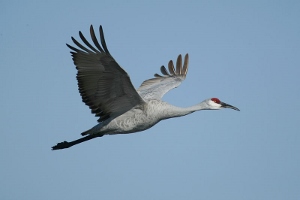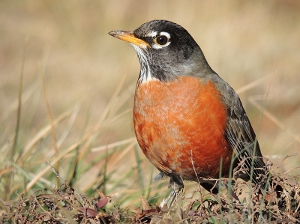Welcome Home, Feathered Friends!
Maybe more than anything else – at least here in the regularly glaciated state of Wisconsin – it’s the arrival of various birds that serve as the most reliable evidence that spring is finally on the way. No matter how cold it is or how much ice and snow continue to cover our sloppy brown landscape, sometime in March, the robins, red-wing blackbirds, sandhill cranes, turkey vultures, Canada geese and assorted other migrants finally arrive. I often wonder how they can appear so confident, particularly when winter seems so doggedly reluctant to give up, but they always seem to know what they’re doing, arriving just in time for the spring thaw.
For whatever reason, I’ve been reading a lot of books about birds lately. While I’m no expert and I don’t travel the country adding birds to any lists, I do confess to a certain fascination with our ubiquitous feathered friends.
It goes without saying that no nature fanatic can do without at least one book for bird identification. Written and illustrated by American ornithologist, David Allen Sibley, The Sibley Guide to Birds is considered by many to be the finest field guide to North American birds. Including over 6600 illustrations, the book presents multiple drawings of each of 810 species, allowing for easier identification of whatever avian creature may cross your path. While the first edition received wide acclaim when it was released in 2000, the subsequent 2014 edition has worrisome font and color contrast issues that have provoked criticism. A fix is in the works, but for the time being the superior first edition is still available on Amazon.
If you’ve got some free time on your hands, there are worse things you could do than to take up bird watching. It’s one of the most popular outdoor hobbies in America and getting started is as easy as simply stepping outside. But be warned, there are those individuals who quickly become addicted, unable to keep themselves from seeking out every last rare warbler or grebe. A Supremely Bad Idea is one man’s story of just such an addiction. Book editor Luke Dempsey tells his hilarious tale of North American birding, joined by his friends Don and Donna Graffiti. Together they travel the country, risking life, limb and their financial well-being in search of the rarest of the rare. A fun read for anyone who loves birds or just good comedic writing. You can read my full review here.
Maybe you’re of a bit more scientific bent, interested in what it is that makes birds so remarkable. In Feathers, biologist and nature writer Thor Hanson pursues the many mysteries of the one feature that make birds unique in the natural world. From their bizarre origins to their unmatched utility as aerodynamic and insulating devices, he explains how the avian feather is properly considered a marvel both physically and biologically. He also includes a lengthy exploration of the many ways that humans and other animals have taken advantage of feathers’ unique properties to serve as decoration, stuffing or protein source. Winner of the 2013 John Burroughs Medal, the book is sure to give you a new feeling of respect the next time you see a duck waddle by in the rain.
If you read a lot of nature writing, like I do, it’s hard not get depressed as humankind’s depredation of the environment appears to continue unabated. However, I’ve found one writer who somehow finds a way to write about the natural world while maintaining a sense of optimism. In The View from Lazy Point, nature writer Carl Safina writes about one year on eastern Long Island, smack dab in the middle of a major thoroughfare for millions of avian migrants every year. When he’s not discussing the lives of birds like osprey, eiders, terns and ruddy turnstones, he’s revealing the secrets of numerous other creatures, like horseshoe crabs, sharks, bluefish, seals and monarch butterflies. A remarkably personal and poignant memoir about the future of our planet, I recommend it to anyone who enjoys passionate nature writing.
Maybe a tropical flavor is more to your liking after a long winter. The birds on the ecologically diverse island of New Guinea worry more about attracting mates than surviving blizzards or migrating across continents and no birds devote more of their waking hours to their sex lives than the flamboyant birds-of-paradise. Acclaimed photographer Tim Laman and Cornell University ornithologist Ed Scholes have recently teamed up to publish Birds of Paradise, a beautifully conceived book of incredible photographs which comprehensively documents the 39 members of this exotic family, some for the first time. As impressive as the photographs are, the descriptions of the authors’ adventures in the ruggedly isolated tropical environment are equally entertaining. My full review is here.
No list of bird books is complete without including the great writer and naturalist Bernd Heinrich, still going strong at age 73. Always willing to get his hands dirty and frequently writing about the natural world he encounters near his cabin in the Maine woods, birds and their behavior are often featured prominently. Uniquely combining a brilliant scientific mind with a superior ability to transform science into entertaining reading, Heinrich often includes much of his own fascinating research in his books. Both Ravens in Winter and The Nesting Season are highly recommended for the ornithologically inclined.
Enough reading to keep you busy for the whole spring season, these books are sure to pique interest in the nature lover in all of us as spring makes its grand arrival. Say “hello” to any avian creatures you encounter as you get out in the bright sunshine and the mud; they may have battled great odds and traveled many miles just to see you.
Bird photos by: Steve Emmons (crane)/Dakota Lynch (robin)/DAVID ILIFF. License: CC-BY-SA 3.0(blackbird)
- Best Non-Fiction of 2016 - February 1, 2017
- Little Free Library Series — Savannah - May 22, 2015
- Little Free Library Series — Wyoming - November 30, 2014




Leave A Comment